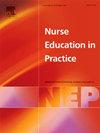护理本科教育中的基因组学要点:讨论文件
IF 3.3
3区 医学
Q1 NURSING
引用次数: 0
摘要
背景自 2003 年人类基因组计划完成以来,基因组科学突飞猛进,基因组学的实际应用彻底改变了医疗保健的各个领域。护理学建立在包括基因组学在内的基础生命科学之上。作为医护人员中人数最多、与病人和家属相处时间最长的群体,护士在医护团队中发挥着至关重要的作用,他们将基因组学知识融入到病人护理中,以改善病人的健康和福祉。因此,护士在接受本科教育时必须掌握基本的基因组知识和技能。然而,护理专业是否以及如何将基因组学纳入其课程存在很大差异。此外,护理专业教师对基础基因组学概念的了解可能有限,对基因组学教学缺乏信心。结论虽然该地图、课程资源、学习成果范例和临床案例都是基于美国开发的领域,但全球护理教师都可以利用这些资源来培养未来的护士,使其能够在入职时提供基于基因组学的护理服务。本文章由计算机程序翻译,如有差异,请以英文原文为准。
Essentials of genomics in nursing undergraduate education: A discussion paper
Aim
To map the 2021 American Association of Colleges of Nursing Essentials to the American Nurses Association Essentials of Genomic Nursing for all nurses and provide resources for nursing faculty to support the seamless integration of genomics into existing undergraduate curricula.
Background
Since the completion of the Human Genome Project in 2003, rapid advancements in genomic science leading to practical applications of genomics have revolutionized all areas of healthcare. Nursing is built on foundational life sciences, including genomics. As the largest segment of the healthcare workforce, who spend the most time with patients and families, nurses play a critical role in healthcare teams integrating genomic knowledge into patient care to improve health and well-being. Consequently, nurses must be equipped with foundational genomic knowledge and skills during their undergraduate education. However, there is wide variability in whether and how nursing programs have incorporated genomics into their curricula. Additionally, nursing faculty may have limited knowledge of foundational genomic concepts and lack confidence in teaching genomics.
Design
Discussion paper
Methods
We aligned domains from the American Association of Colleges of Nursing Essentials and American Nurses Association Essentials of Genomic Nursing.
Results
A map illustrating alignment in multiple areas, which provide examples of ways to integrate genomics into existing nursing curricula.
Conclusion
Although based on domains developed in the United States, the map, curricular resources, example learning outcomes, and clinical vignettes can be used by nursing faculty globally to prepare future nurses who are competent in providing genomics-informed nursing care on entry-to-practice.
求助全文
通过发布文献求助,成功后即可免费获取论文全文。
去求助
来源期刊

Nurse Education in Practice
NURSING-
CiteScore
5.40
自引率
9.40%
发文量
180
审稿时长
51 days
期刊介绍:
Nurse Education in Practice enables lecturers and practitioners to both share and disseminate evidence that demonstrates the actual practice of education as it is experienced in the realities of their respective work environments. It is supportive of new authors and will be at the forefront in publishing individual and collaborative papers that demonstrate the link between education and practice.
 求助内容:
求助内容: 应助结果提醒方式:
应助结果提醒方式:


